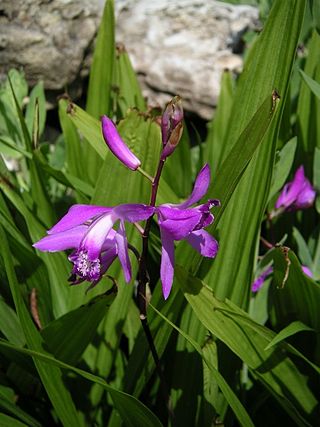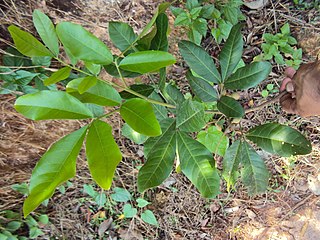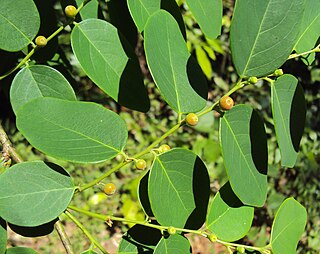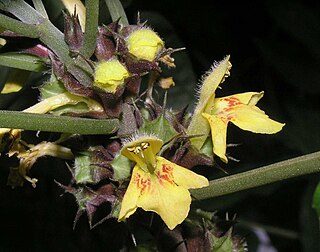
Bletilla, common name urn orchid, is a temperate, terrestrial genus of orchids containing five currently recognized species distributed through China, Japan, Taiwan, south to Vietnam, Thailand and Myanmar. The name is actually a diminutive of Bletia because of the resemblance between the two genera even though Bletia is a New World genus. The genera JimensiaRaf. and PolytomaLour. ex Gomes are generally included into Bletilla. This genus is abbreviated Ble in trade journals.

Phoebe is a genus of evergreen trees and shrubs belonging to the Laurel family, Lauraceae. There are 75 accepted species in the genus, distributed in tropical and subtropical Asia and New Guinea. 35 species occur in China, of which 27 are endemic. The first description of the genus was of the type species P. lanceolata made in 1836 by Christian Gottfried Daniel Nees von Esenbeck in Systema Laurinarum, p. 98.

Bunzō Hayata was a Japanese botanist noted for his taxonomic work in Japan and Formosa, present day Taiwan.

Castanea mollissima, also known as the Chinese chestnut, is a member of the family Fagaceae, and a species of chestnut native to China, Taiwan, and Korea.

Ulmus uyematsuiHayata, commonly known as the Alishan elm, is endemic to forests at elevations of 800–2,500 metres (2,600–8,200 ft) in Alishan, Chiayi County, central Taiwan, where it is considered one of the minor tree species. The tree was first named and described by the Japanese botanist Bunzō Hayata in 1913, in the aftermath of the First Sino-Japanese War, when the Republic of Formosa was ceded to Japan.

Calocedrus formosana is a conifer endemic to Taiwan.

Gynura is a genus of flowering plants in the daisy family Asteraceae native to Asia. The best known species is Gynura aurantiaca, often grown as a house plant. This plant is commonly known as purple passion because of the velvety purple leaves.

Abies kawakamii is a species of conifer in the family Pinaceae. It is found only in Taiwan. First described in 1908 by Bunzō Hayata as a variety of Abies mariesii, a high-mountain fir native to Japan; the next year it was elevated to species rank by Tokutarô Itô. Abies kawakamii is exclusively native to the island of Taiwan, and is one of the southernmost true firs. It is a high-mountain species occurring in northern and central Taiwan at elevations between 2400 and 3800 m in association with other temperate plants, dominantly conifers, including Juniperus formosana var. formosana, Tsuga formosana, and Juniperus morrisonicola.

Juniperus formosana, the Formosan juniper, is a species of conifer in the family Cupressaceae. It is a shrub or tree to 15 metres tall, found in China and in Taiwan.

Adinandra is a genus of plant in the family Pentaphylacaceae. It contains the following species:

Aglaia elaeagnoidea, the droopy leaf or priyangu, is a species of plant in the family Meliaceae. It is a 10m tall tree found in American Samoa, Australia, Cambodia, China, India, Indonesia, Malaysia, New Caledonia, Papua New Guinea, the Philippines, Samoa, Sri Lanka, Taiwan ), Thailand, Vanuatu, and Vietnam.

Euchresta is a genus of flowering plants in the family Fabaceae. It belongs to the subfamily Faboideae. All species are native to East Asia.

The Trictenotomidae are a small family of beetles in the superfamily Tenebrionoidea, containing fifteen species in two genera. Most species are found in the Oriental realm where they live in montane forest habitats. The family is considered, based on larval characters as well as sequence-based studies, to be closely related to the Salpingidae.

Breynia vitis-idaea, the officinal breynia, is a perennial tree-like species of Phyllanthaceae, found from India east to Taiwan and Okinawa and south to Indonesia. It is a shrub or treelet with egg-shaped leaves that can reach up to 3 m tall. It has staminate flowers and spherical, red fruit.

Liquidambar formosana, commonly known as the Formosan gum, Chinese sweet gum and Formosa sweet gum, is a species of tree in the family Altingiaceae native to East Asia.

Paraphlomis is a genus of flowering plants in the mint family, Lamiaceae, first described in 1901. It is native to China, Himalayas, and Southeast Asia.
Hypericum nagasawae is a species of the large genus Hypericum in the Hypericaceae family. It is native to Taiwan.

Hina Hayata is a Japanese international table tennis player. She is the most successful player on the ITTF Challenge Series since its inception in 2017. Owing to her stature, she is able to generate powerful spins on both wings more so than most female players.
Excoecaria formosana is a species of flowering plant in the family Euphorbiaceae. It was originally described as Excoecaria crenulata var. formosanaHayata. It is native to Nansei-shoto, Japan and Taiwan.
Kitagawia is a genus of flowering plants belonging to the family Apiaceae.

















